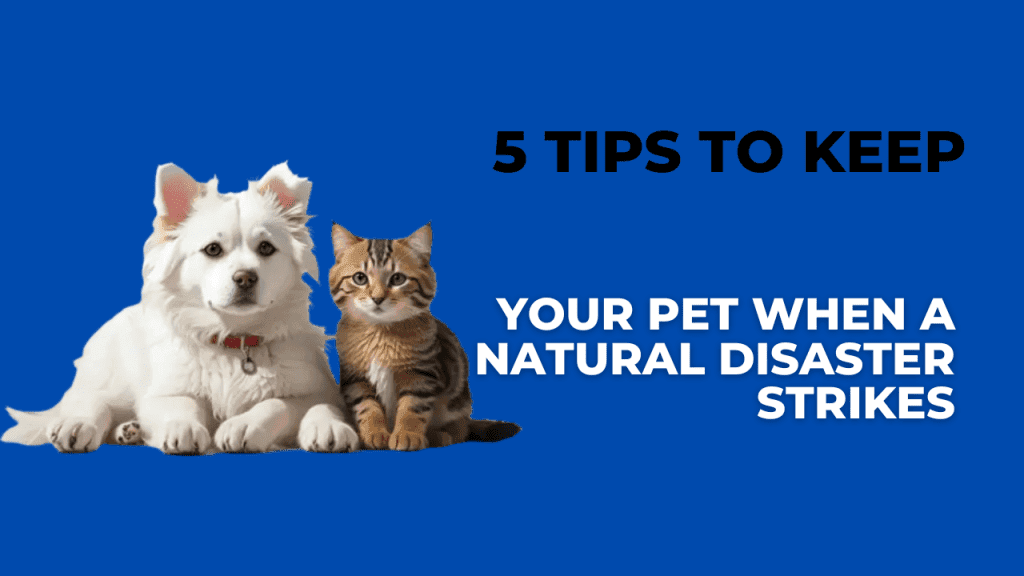5 Tips to Keep Your Pet When a Natural Disaster Strikes
When a natural disaster strikes, ensuring the safety of your pets can be challenging. Here are five essential tips to help keep your pets safe:
1. Create an Emergency Kit for Your Pet
Prepare a pet emergency kit that includes:
- Enough food and water for at least 3–7 days.
- Medications your pet needs, along with a basic first-aid kit.
- Leashes, harnesses, and carriers for transport.
- Waste disposal items (litter box for cats, poop bags for dogs).
- Comfort items like blankets, toys, and treats to reduce stress.
- Copies of veterinary records and identification tags.
2. Make an Evacuation Plan
Know in advance where you’ll go if you need to evacuate, and make sure that wherever you’re going (shelter, hotel, or friend’s house) will accept pets. Identify pet-friendly accommodations and emergency shelters beforehand. Also, arrange a backup plan in case you’re separated from your pet or unable to reach them quickly.
3. Keep Your Pet Properly Identified
Ensure your pet is microchipped, and that the contact information is up to date. Additionally, they should wear a collar with an ID tag that includes their current phone number. This makes reunification easier if you’re separated during an emergency.
4. Stay Informed and Know the Local Risks
Monitor local weather alerts and warnings for the types of natural disasters common in your area. Download emergency alert apps and follow the advice of local authorities regarding evacuations and disaster responses. Being prepared and acting quickly is critical.
5. Practice Pet Evacuation Drills
Familiarize your pets with their crates or carriers, so they’re comfortable entering them quickly. Practice evacuation drills to reduce panic when a real emergency happens. Be sure to keep leashes, carriers, and emergency supplies accessible and easy to grab when time is limited.
These steps can significantly improve your pets’ safety during natural disasters, helping them stay calm and secure when you need to act fast.
How to Protect Your Dog During a Natural Disaster
Protecting your dog during a natural disaster requires preparation and quick action. Here’s how to ensure your dog’s safety:
1. Prepare a Dog Emergency Kit
Assemble a kit that contains:
- At least 3–7 days’ worth of food and water.
- Any necessary medications, along with a first-aid kit for dogs.
- Collapsible bowls, waste bags, and a leash or harness.
- A blanket or bedding for comfort.
- Familiar toys or treats to reduce stress.
- Copies of vet records, vaccination info, and ID tags.
2. Ensure Your Dog Has Proper Identification
Ensure your dog is microchipped and wears a collar with up-to-date contact information. This helps reunite you if you get separated during the disaster.
3. Plan for Evacuation
Know where you can take your dog if evacuation becomes necessary. Identify pet-friendly shelters, hotels, or family homes that are willing to accommodate your dog. Have a plan for transporting your dog safely, and practice loading your dog into a car or crate.
4. Monitor Local Alerts
Stay informed by monitoring local weather reports or emergency notifications. Knowing about the disaster in advance gives you time to gather supplies and evacuate with your dog if necessary. In case of a sudden disaster, such as an earthquake, stay prepared by having a quick escape bag for your dog.
5. Keep Your Dog Calm
Natural disasters can be stressful for dogs. Keeping them calm is essential for their well-being. Speak in a soothing voice and avoid leaving them alone in a tense situation. Comfort them with their favourite blanket or toy, and, if possible, remain in a quiet area where your dog feels secure.
6. Have a Plan for After the Disaster
Once the immediate threat passes, monitor your dog for signs of stress or injury. After disasters, the environment may be dangerous, with debris or contaminated water. Keep your dog on a leash when exploring unfamiliar areas, and check for injuries or health issues. Have a backup plan for housing your dog in case your home is not safe to return to right away.
These steps will help ensure that your dog is well-protected and cared for during any emergency.

Here’s What to Do with Your Pet When a Natural Disaster Strikes
When a natural disaster strikes, it’s crucial to have a plan in place for your pet. Here’s what to do to keep your pet safe during the chaos:
1. Bring Your Pet Indoors Immediately
As soon as you’re aware of an approaching disaster, bring your pet inside. This keeps them from running off in panic or getting injured by the elements. For dogs and outdoor cats, this is especially important to ensure they are within reach.
2. Secure Your Pet in a Carrier or Leash
In a disaster, pets can become frightened and unpredictable. To prevent them from running away or hiding, keep dogs on a leash and place cats in a carrier. Secure them in a designated safe area of your home, preferably a windowless room or a basement, if you’re sheltering in place.
3. Evacuate with Your Pet
Never leave your pet behind if you need to evacuate. If the situation is unsafe for you, it’s unsafe for them too. Grab your pet emergency kit and safely transport your pet to your evacuation location. Make sure you have a clear plan for pet-friendly shelters, hotels, or friends’ homes.
4. Remain Calm to Soothe Your Pet
Pets can sense your emotions, so staying calm will help keep them calm. Speak to them softly, give them familiar items like their favourite toy or blanket, and reassure them as best you can during the event.
5. Listen to Authorities and Monitor Updates
Follow evacuation orders or other emergency guidance from local authorities. Stay tuned to weather or emergency alerts to know when it’s safe to return home or whether you should stay put longer.
6. Check for Injuries After the Disaster
Once the immediate danger passes, check your pet for injuries. They might have hurt themselves in the panic or from environmental hazards like debris. Contact your veterinarian if you notice any signs of distress or injury.
7. Don’t Let Your Pet Roam Freely
Even after the disaster is over, the environment may still be hazardous. Keep your pet on a leash or in a carrier until you’re sure the area is safe. There could be broken glass, downed power lines, or unsafe water sources that could harm them.


By being prepared, staying calm, and acting quickly, you can ensure your pet stays safe during a natural disaster.
10 tips to keep your dog healthy and happy
Table of Contents
Toggle




